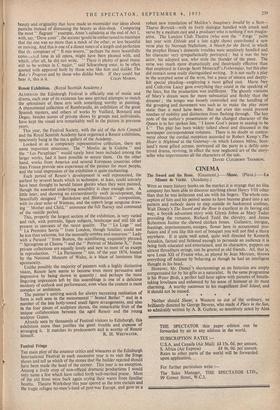Renoir Exhibition. (Royal Scottish Academy.) ALTHOUGH the Edinburgh Festival is
officially one of music and drama, each year of its existence has seen spirited attempts to match the splendours of these arts with something worthy in painting. A phenomenal collection of Rembrandts, an exhibition of the great Spanish masters, and others of works by Vuillard, Bonnard and Degas, besides scores of private shows by groups and individuals, have kept the visual arts remarkably well in the picture in previous years. This, year, the Festival Society, with the aid of the Arts Council and the Royal Scottish Academy have organised a Renoir exhibition, spaciously hung in the ma.n gallery of the Academy.
Looked at as a completely representative collection, there are some important omissions. The " Moulin de la Galette " and the " Les Parapluies" would surely have been included among the larger works, had it been possible to secure them. On the other hand, works from America and several European countries other than France provide new experience of the painter for most people, and the total impression of the exhibition is quite enchanting.
Each period of Renoir's development is well represented, the earliest by several heads which in technique, at least, could scarcely have been thought to herald future glories when they were painted, though the essential underlying sensibility is clear enough now. A little later, and showing an extraordinarily swift development, the beautifully designed " Battledore and Shuttlecock " composition, with its clear echo of Watteau, and the superb large sanguine draw- ing " Mother and Child," announce the full fluency and command of the middle period. This, properly the largest section of the exhibition, is very varied and rich, with portraits, figure subjects, landscape and still life all present in canvases of the rarest quality. The " La Loge " and " La Premiere Sortie " from London, though familiar, could not be less than welcome, but the unusually sombre and sonorous " Lady with a Parasol " from Boston, the scintillating, exquisitely phrased " Springtime at Chatou ". and the " Portrait of Madame X," from private collections are equally lovely and new to most of us except in reproduction. " La Parisienne " too, of year 1874, loaned by the National Museum of Wales, is a blaze of luminous blue spontaneity. Unlike possibly the majority of painters with a highly distinctive vision, Renoir here seems to become even more persuasive and impressive by being shown in quantity ; and perhaps the most lingering impression left by this assemblage is one of a delicious modesty of outlook and performance, even when the content is most complex or ambitious. The painter's untiring search for always increasing realisation of form is well seen in the monumental " Seated Bather " and in a number of the late hotly-toned small figure arrangements, and also in the four pieces of sculpture shown, the remarkable fruit of the unique collaboration between the aged Renoir and the young sculptor Guino. Already seen by thousands of Festival visitors to Edinburgh, this exhibition more than justifies the great trouble and expense of arranging it. It matches its predecessors and is worthy of Renoir


































 Previous page
Previous page